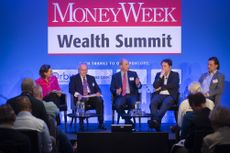Expect more turbulence as the market calls central bankers’ bluff
With bond yields climbing and stockmarkets sliding, markets are hoping central bankers will step in again to repress interest rates – but that won’t happen until we get a much deeper correction, says John Stepek.


You know that market tantrum I mentioned yesterday? It looks like we did end up getting a taste of it. The US Nasdaq index dropped sharply as bond yields in the US (and elsewhere in the world) rose sharply. So what happens next?
Bond yields spiked yesterday, with the ten-year US Treasury rising above 1.6% at one point. In absolute and historic terms, that’s still one of the lowest levels on record.
But it’s not about the level. It’s about the direction and the pace of move in that direction. We’ve been used to bond yields going down for about 40 years. The reason markets get twitchy when they move in the opposite direction is because it would have massive implications for everything else. It would mark a reversal of the single biggest trend in financial markets for almost everyone’s entire investing lifetimes. It’s a big deal.
Subscribe to MoneyWeek
Subscribe to MoneyWeek today and get your first six magazine issues absolutely FREE

Sign up to Money Morning
Don't miss the latest investment and personal finances news, market analysis, plus money-saving tips with our free twice-daily newsletter
Don't miss the latest investment and personal finances news, market analysis, plus money-saving tips with our free twice-daily newsletter
Central bankers are not going to go Volcker on us any day soon
The reason yields are going up now is because investors are starting to think that inflation will return, and not just in the short term. The reason they haven’t gone up faster is because investors also think (or hope) that central banks will not react to inflation – they won’t raise interest rates. In fact, investors hope that central bankers will repress interest rates.
So will they? I suspect so. Since 2008 (if not before), the Federal Reserve has only become increasingly willing to step in and smooth away any problems that threaten to derail the bull market in shares. You need only look at the reaction during the pandemic to see that. A flood of money, not just into the US but globally, with virtually no questions asked.
So is there any chance that this Fed is about to pull a Paul Volcker, and send rates right up to stifle rising prices? No chance. Not least because Volcker only did what he did (hiking interest rates to punishing levels in the early 1980s) because inflation was rising at double-digit rates. You could certainly argue that he took the tough decisions but you could also argue that he didn’t have much choice. All of his options were bad.
Anyway. Central banks have said that they’re not fazed by inflation and that they want to focus on growth. So if rising borrowing costs (ie, higher bond yields) threaten that growth, they’ll have to step in and do something about it. The question is the timing. Central bankers don’t want to admit that they’ll “do what it takes”. They’d rather that the market trusted them to be pro-inflation, rather than get into the politically difficult territory of spelling it out.
The problem is that, markets being markets, they’ll force central banks to prove the point. They’ll push this until the banks push back. But that means that we’ll need to get a bigger correction. Because that’s what the central bankers will need to happen before they can justify acting.
Be prepared – we might get some buying opportunities before too long
The thing about corrections is that they pull down just about everything. I’ve been watching the FTSE 100 with interest, for example. In the last month, the FTSE has outperformed the US tech index quite strongly.
This is what I’d expect to happen, given that one index (the tech-heavy Nasdaq) doesn’t like rising bond yields whereas the bank-heavy FTSE 100 is much more open to them. However, at the same time, you’re not going to be jumping with excitement if you’re a FTSE 100 investor, because you’re only flat on the month. It’s just that this is significantly better than the 5% loss a Nasdaq investor has had to put up with.
My point is that when investors enter “sell” mode, they sell fairly indiscriminately. The US is the world’s most important market, so in the short term it doesn’t matter that it’s way more expensive than any other market – where it goes, others will follow. It’s just the way it works.
It’s also worth remembering that because of where we are in the cycle – extreme exuberance and rampant fear of missing out – an awful lot of people have bet on the world’s most popular stocks with an awful lot of borrowed money. Some of these investors have no margin of safety whatsoever. Their only strategy is to sell any good stuff they own to meet margin calls and also try to average down on the riskiest stuff that they own (which is suddenly entirely illiquid in practical terms because no one wants to buy it) and hope that it goes up.
As the saying goes, hope is not a strategy. So you get forced selling, knock-on effects, things start to break down, and usually that’s when the central bank panics and steps in – we’ve all been here before. So don’t be surprised if things get a little bumpy in the coming weeks.
However, it’s also during these little periods of panic and dashing for liquidity that the well-prepared investor can find themselves the odd bargain, as long as they’ve done their homework in advance.
So what should you do? As I’m always saying, have a plan. Have a watchlist of stocks or assets that you would like to buy and hold for the long run. When you spot them being sold for appealing prices because someone needs to sell the family silver in order to pay the rental fees on their deep-in-the-red Tesla shares, that’s when you step in to take it off their hands (this by the way, is why you always make sure that part of your portfolio is held as cash. So you can take these opportunities when they arise).
So that’s it. If you don’t have a plan, why not set aside some time this weekend to build a watchlist and review your portfolio, and consider what you think it should look like versus what it currently looks like? We’re still in the calm before the storm here. It’s better to have a plan in advance, rather than try to cobble one together mid-panic.
For more on all this, make sure you subscribe to MoneyWeek magazine. Get your first six issues free here.
John is the executive editor of MoneyWeek and writes our daily investment email, Money Morning. John graduated from Strathclyde University with a degree in psychology in 1996 and has always been fascinated by the gap between the way the market works in theory and the way it works in practice, and by how our deep-rooted instincts work against our best interests as investors.
He started out in journalism by writing articles about the specific business challenges facing family firms. In 2003, he took a job on the finance desk of Teletext, where he spent two years covering the markets and breaking financial news. John joined MoneyWeek in 2005.
His work has been published in Families in Business, Shares magazine, Spear's Magazine, The Sunday Times, and The Spectator among others. He has also appeared as an expert commentator on BBC Radio 4's Today programme, BBC Radio Scotland, Newsnight, Daily Politics and Bloomberg. His first book, on contrarian investing, The Sceptical Investor, was released in March 2019. You can follow John on Twitter at @john_stepek.
-
 Should you sell in May this year?
Should you sell in May this year?The market adage looks unlikely to apply in 2024, and global equities are proving resilient
By Max King Published
-
 Should you invest in UK equities?
Should you invest in UK equities?The FTSE 100 hit a record high this week, but UK equities remain unloved and undervalued compared to their global and US peers. Should you snap them up at a discount?
By Katie Williams Published
-
 Halifax: House price slump continues as prices slide for the sixth consecutive month
Halifax: House price slump continues as prices slide for the sixth consecutive monthUK house prices fell again in September as buyers returned, but the slowdown was not as fast as anticipated, latest Halifax data shows. Where are house prices falling the most?
By Kalpana Fitzpatrick Published
-
 Rents hit a record high - but is the opportunity for buy-to-let investors still strong?
Rents hit a record high - but is the opportunity for buy-to-let investors still strong?UK rent prices have hit a record high with the average hitting over £1,200 a month says Rightmove. Are there still opportunities in buy-to-let?
By Marc Shoffman Published
-
 Pension savers turn to gold investments
Pension savers turn to gold investmentsInvestors are racing to buy gold to protect their pensions from a stock market correction and high inflation, experts say
By Ruth Emery Published
-
 Where to find the best returns from student accommodation
Where to find the best returns from student accommodationStudent accommodation can be a lucrative investment if you know where to look.
By Marc Shoffman Published
-
 Best investing apps
Best investing appsWe round up the best investing apps. Looking for an easy-to-use app to help you start investing, keep track of your portfolio or make trades on the go?
By Ruth Emery Last updated
-
 The world’s best bargain stocks
The world’s best bargain stocksSearching for bargain stocks with Alec Cutler of the Orbis Global Balanced Fund, who tells Andrew Van Sickle which sectors are being overlooked.
By Andrew Van Sickle Published
-
 Revealed: the cheapest cities to own a home in Britain
Revealed: the cheapest cities to own a home in BritainNew research reveals the cheapest cities to own a home, taking account of mortgage payments, utility bills and council tax
By Ruth Emery Published
-
 UK recession: How to protect your portfolio
UK recession: How to protect your portfolioAs the UK recession is confirmed, we look at ways to protect your wealth.
By Henry Sandercock Last updated